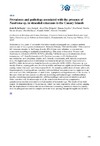Please use this identifier to cite or link to this item:
https://accedacris.ulpgc.es/handle/10553/71337
| Title: | Prevalence and pathology associated with the presence of Nasitrema sp. in stranded cetaceans in the Canary Islands | Authors: | De La Fuente Marquez, Jesus Xuriach, Aina Diaz Delgado, Josue Sacchini , Simona Sierra Pulpillo, Eva María García-Álvarez, Natalia Zucca, Daniele Arbelo, Manuel Fernández Rodríguez, Antonio Jesús |
UNESCO Clasification: | 310907 Patología 3109 Ciencias veterinarias |
Issue Date: | 2016 | Abstract: | Nasitrema sp. is a genus of trematodes that infests nasal and pterygoid sacs, tympano-periotic complex and nervous system of odontocetes. Between February 2000 and December 2014 a total of 641 cetaceans stranded in the Canary Islands, 458 of them were submitted to post-mortem examination according to standardized methodology. This study is focused on 50 cases with Nasitrema sp. infestation (50/458, 10.92%), affecting 7 different species of odontocetes (Steno bredanensis, n=7; Stenella frontalis, n=11; Tursiops truncatus, n=13; Globicephala macrorhynchus, n=4; Delphinus delphis, n=5; Stenella coeruleoalba, n=8; Stenella longirostris, n=2). The highest prevalence of infestation was found in the species Stenella longirostris (2/3; 66.67%), while the lowest was found in Stenella coeruleoalba (8/90, 8.89%). Nasitrema sp. was mainly observed in pterygoids sacs, but also in middle and inner ear, eighth cranial nerve and brain, causing lesions that could have been responsible for the stranding and/or death of some individuals. Macroscopically, in pterygoid sacs was observed a multifocal, moderate to severe, suppurative and ulcerative sacculitis, with presence of adult flukes, hyperplasia and hyperkeratosis of the mucosa. In the cases where nervous system was affected, necrotizing and haemorrhagic vestibulocochlear neuritis, necrotizing meningoencephalitis with haemorrhages and occasional intralesional adult flukes was observed. At microscopic level, the main lesion observed was a suppurative granulomatous reaction associated with high number of trematode eggs. The results of our study support the migration theory of Nasitrema sp., which has been proposed by others authors, arguing that the displacement of trematodes larvae is between surrounding anatomical structures, namely, from the pterygoid sacs and the complex ear to the brain, passing through the eighth cranial nerve. | URI: | https://accedacris.ulpgc.es/handle/10553/71337 | Source: | 30th Annual Conference of the European Cetacean Society. Madeira, Portugal, 14-16 March 2016 / Luís Freitas; Cláudia Ribeiro (ed.), p. 238 |
| Appears in Collections: | Actas de congresos |
Items in accedaCRIS are protected by copyright, with all rights reserved, unless otherwise indicated.
